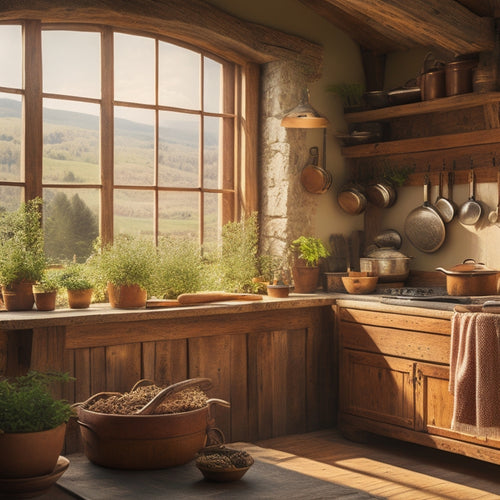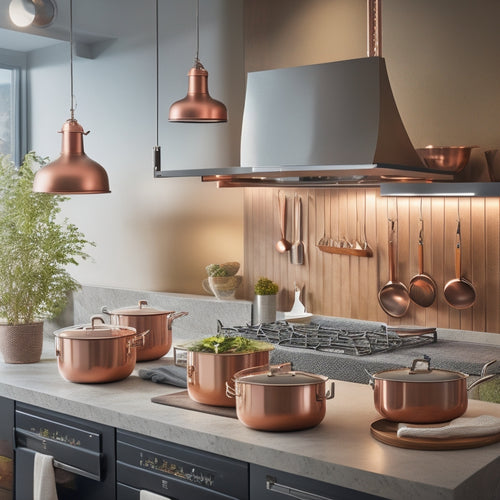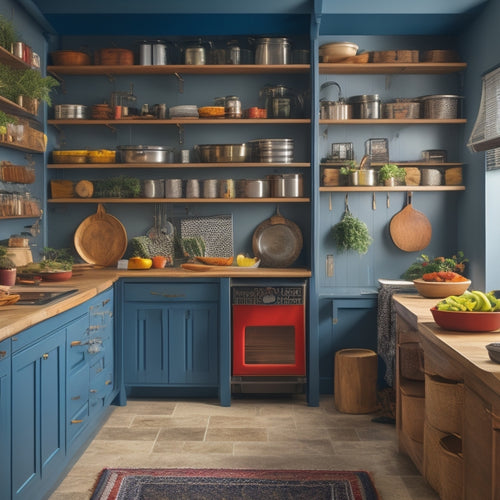
What's Holding You Back From a Seamless Kitchen?
Share
You're struggling to create a seamless kitchen, and it's not hard to see why. A poorly planned layout is hindering your workflow, while inadequate storage and shelving are leaving you cluttered and cramped. Cluttered countertops and surfaces are making meal prep a nightmare, and inefficient traffic flow patterns are causing chaos. Add to that insufficient task lighting, disorganized utensils, and a lack of functional zones, and it's no wonder cooking has become a stressful scramble. And let's not forget about outdated appliances and inadequate waste management. The good news is that overcoming these obstacles can be just a step away from a kitchen that flows like a dream.
Key Takeaways
• A poorly planned kitchen layout can hinder workflow, making it difficult to achieve a seamless kitchen experience.
• Inadequate storage solutions can lead to clutter, disorganization, and wasted time searching for essentials.
• Insufficient task lighting can make cooking and food preparation a struggle, leading to frustration and decreased productivity.
• Failure to designate functional zones in the kitchen can result in chaos, inefficiency, and a lack of focus.
• Outdated appliances can be energy-inefficient, inconvenient, and aesthetically unappealing, holding you back from a seamless kitchen.
Poorly Planned Kitchen Layout
As you step into your kitchen, you're immediately confronted with a bewildering maze of countertops, appliances, and cabinets that seem to clash rather than harmonize, a jarring evidence to the results of a poorly planned kitchen layout. The result is a space that's more frustrating than functional, where every task feels like an obstacle course.
A well-designed kitchen, on the other hand, is built around the concept of a Functional Work Triangle, where the sink, stove, and refrigerator form the points of a triangle that streamlines your workflow. This thoughtful design enables you to move effortlessly between tasks, saving time and energy.
Ample Counter Space is also vital, providing a comfortable and efficient area for food preparation. Additionally, an Ergonomic Design guarantees that every element, from the height of the countertops to the placement of the appliances, is tailored to your needs, reducing fatigue and strain.
Inadequate Storage and Shelving
Cluttered countertops and crowded shelves scream for attention, overwhelming your senses as you struggle to find a place for every item in your kitchen, a stark reminder that inadequate storage and shelving can quickly turn your kitchen into a chaotic nightmare.
As you navigate the space, you're constantly reminded of the importance of effective storage solutions. Here are a few areas where you might be falling short:
-
Pantry organization: Is your pantry a black hole where food and cooking supplies disappear? A well-organized pantry with baskets, bins, and labels can make meal prep a breeze.
-
Your custom cabinetry is lacking, leaving you with awkward gaps and unusable corners.
-
You're wasting precious floor space with clunky appliances and bulky furniture.
-
Your shelves are overcrowded, making it difficult to find what you need when you need it.
-
You're sacrificing style for functionality, settling for a kitchen that's more cluttered than chic.
Cluttered Countertops and Surfaces
Every time you step into your kitchen, you're confronted with a jarring landscape of appliances, utensils, and snacks vying for space on your countertops, making it impossible to focus on the task at hand. The cluttered countertops and surfaces are a visual overload, making you feel anxious and overwhelmed.
It's time to reclaim your kitchen's serenity by embracing clutter organization and minimalist design. Start by decluttering your countertops, sorting items into categories, and assigning a designated spot for each. Implement surface space management by allocating specific zones for food preparation, cooking, and storage.
Invest in space-saving solutions like wall-mounted shelves, hooks, and baskets to maximize your kitchen's vertical space. By adopting these decluttering tips, you'll create a sense of calm and clarity, allowing you to focus on what matters most – serving delicious meals to your loved ones.
As you cook and serve, you'll appreciate the joy of working in a harmonious, clutter-free space that sparks creativity and inspires connection.
Inefficient Traffic Flow Patterns
When you navigate your kitchen, you're forced to dodge and weave around obstacles, like a dance partner sidestepping furniture, because the inefficient traffic flow patterns hinder your movement and make cooking a frustrating experience. It's like trying to solve a puzzle, except the pieces keep shifting, and you're left feeling frazzled and overwhelmed.
The truth is, poor spatial planning is the root of this problem. It leads to traffic congestion, making it difficult to move around the kitchen efficiently. Imagine being able to glide effortlessly from the stove to the sink, without having to navigate a maze of appliances and countertops. That's what flow optimization can do for you. By rethinking your circulation patterns, you can create a kitchen that's designed for movement, not obstacles.
Here are some common traffic flow pattern pitfalls to watch out for:
- Narrow walkways between countertops and appliances
- Placing frequently used items in hard-to-reach areas
- Inadequate clearance around the cooking station
- Poorly positioned trash cans and recycling bins
- Insufficient floor space for food preparation and cooking
Insufficient Task Lighting Design
As you navigate your newly optimized traffic flow, you're still stuck in the dark, literally, because the absence of task lighting design leaves you fumbling for ingredients and struggling to read recipe instructions. Dim lighting in your kitchen creates an atmosphere that's more frustrating than inviting, making it difficult to focus on the task at hand. Besides, glare issues from overhead lighting can be just as distracting, causing you to squint and strain your eyes.
Imagine being able to effortlessly chop, dice, and sauté with precision, thanks to targeted lighting that illuminates your workstations. Task lighting design can make all the difference, providing the necessary brightness and contrast to bring your culinary creations to life.
By strategically placing under-cabinet lighting, pendant lights, or LED strips, you can create a kitchen that's not only functional but also visually appealing. With sufficient task lighting, you'll be able to whip up a storm, and your guests will be impressed by the attention to detail that goes into every dish you serve.
It's time to shed some light on your kitchen's potential!
Unorganized Kitchen Utensils Storage
You're surrounded by a jumble of utensils, gadgets, and gizmos that clutter your countertops and drawers, making it impossible to find what you need in the heat of cooking. It's frustrating, to say the least, when you're in the middle of preparing a meal and can't locate the garlic press or the silicone spatula.
-
You've got utensils scattered all over the countertops, making it difficult to wipe them clean.
-
Your drawers are a mess, with utensils tangled together like a puzzle.
-
You've got duplicate items because you can't find what you already have.
-
You're wasting precious time searching for that one specific tool.
-
You're feeling overwhelmed and stressed in your own kitchen.
To tackle this chaos, it's time to implement a container organization system that keeps your utensils and gadgets tidy and within reach. Invest in drawer dividers that separate your utensils into categories, making it easy to find what you need when you need it.
With a little bit of planning and creativity, you can transform your kitchen into a seamless and efficient space that sparks joy and inspires delicious meals.
Inadequate Waste Management System
Now that your utensils are neatly organized, it's time to tackle the unsightly trash and recyclables that clutter your kitchen, making it difficult to maintain a clean and hygienic space. An inadequate waste management system can lead to a messy kitchen, which can be overwhelming and stressful. It's essential to create a system that works for you and your household.
| Waste Management Solution | Benefits |
|---|---|
| Recycling bins | Separates recyclables from trash, reduces waste sent to landfills, and conserves natural resources |
| Composting system | Turns food waste into nutrient-rich soil, reduces greenhouse gas emissions, and creates a natural fertilizer |
| Regular trash cans | Holds non-recyclable waste, keeps kitchen clean and organized, and prevents pest infestations |
Lack of Functional Zones
Without designated functional zones, your kitchen becomes a chaotic workspace where meal prep, cooking, and cleanup blur together, making it difficult to stay focused and efficient. This lack of zone organization leads to a cluttered and overwhelming environment, hindering your ability to serve others with ease.
To create a seamless kitchen, consider dividing your space into distinct functional zones. This includes:
-
Prep Zone: A designated area for meal prep, equipped with ample counter space, utensils, and storage for ingredients.
-
Cooking Zone: A central area for cooking, featuring your cooktop, oven, and essential cookware.
-
Cleanup Zone: A designated area for washing dishes, complete with a sink, dishwasher, and storage for cleaning supplies.
-
Storage Zone: A designated area for storing kitchen essentials, such as pots, pans, and utensils.
-
Beverage Zone: A designated area for coffee, tea, or other beverages, complete with a coffee maker, tea infuser, and storage for cups and mugs.
Outdated Kitchen Appliances
Every time you step into your kitchen, outdated appliances seem to scream for attention, their faded finishes, worn-out buttons, and clunky designs disrupting the harmony of your culinary space. It's like they're begging to be replaced with sleek, modern alternatives that will elevate your cooking experience.
Here are some key benefits of upgrading your appliances:
| Upgrade Feature | Benefits |
| Energy Efficient Upgrades | Reduce energy consumption, lower utility bills, and minimize environmental impact |
| Smart Technology Integration | Streamline cooking processes, access recipes, and control appliances remotely for added convenience |
| Modern Designs | Enhance kitchen aesthetics, improve functionality, and create a cohesive look |
Frequently Asked Questions
How Do I Choose the Right Kitchen Style for My Personal Taste?
"As you step into your kitchen, imagine yourself in a Renaissance-era villa, surrounded by rustic charm. Now, choose a style that fits you: consider color schemes, layout, cabinetry options, and countertop materials that reflect your personality, and voilà, your dream kitchen unfolds!"
Can a Small Kitchen Still Have a Functional Island?
You can absolutely fit a functional island in a small kitchen! Opt for space-saving solutions like a cart or nesting tables, and incorporate multifunctional furniture, such as a storage-rich island with a built-in sink or cooktop.
Are There Any Eco-Friendly Kitchen Design Options Available?
You're on the hunt for an eco-friendly kitchen, and you're wondering if it's possible to create a space that's both stylish and sustainable. The answer is yes! You can opt for sustainable materials, energy-efficient appliances, and green kitchen practices with eco-friendly finishes that make a difference.
How Often Should I Replace My Kitchen Appliances?
You'll want to replace your kitchen appliances every 10-15 years, depending on usage and appliance lifespan. Proper maintenance tips like cleaning, defrosting, and updating filters can extend their life, saving you time and money in the long run.
Can I DIY My Kitchen Renovation or Do I Need a Professional?
"Did you know 64% of homeowners regret not hiring a pro for their kitchen renovation? Considering your budget and time commitment, ask yourself: can you realistically dedicate 10-20% of your project's budget to unexpected expenses and 3-6 months of your life to DIY chaos?"
Related Posts
-

Rustic Hanging Racks for Country-Style Kitchens
Rustic hanging racks are a game changer for your country-style kitchen, blending functionality with charm. They maxim...
-

Ceiling-Mounted Pot Racks for Professional Chefs
Ceiling-mounted pot racks are revolutionary for professional chefs like you. They make use of vertical space, keeping...
-

Over-The-Door Kitchen Storage for Large Families
Over-the-door kitchen storage is a transformative solution for large families. It maximizes vertical space, keeping y...


